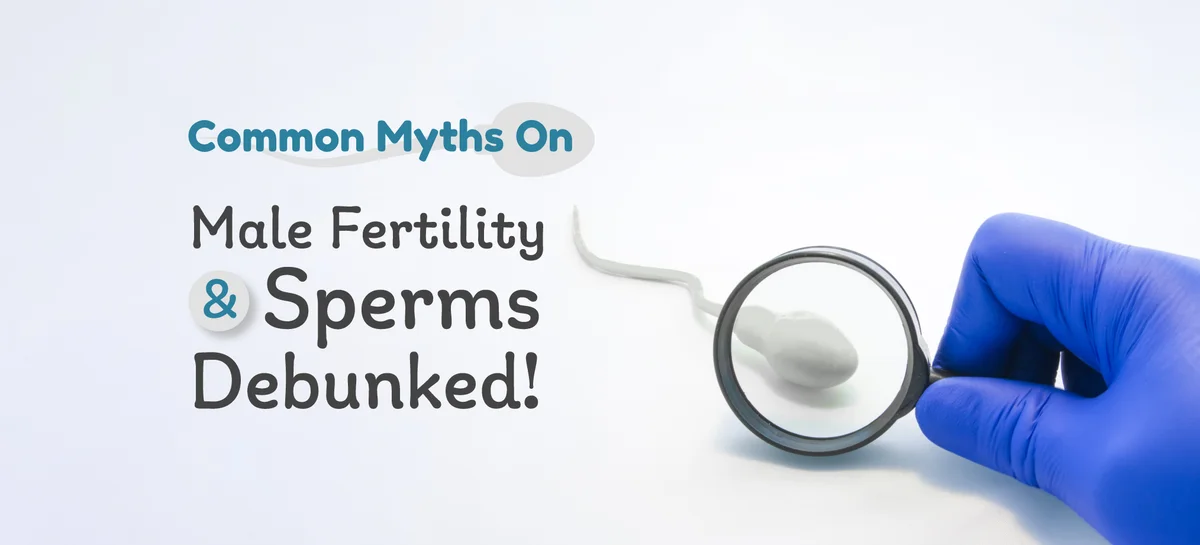- Home
- Blog
- Men's Grooming
Busting Common Myths About Sperm Production, Quality & Fertility In Men
Men's Grooming
Busting Common Myths About Sperm Production, Quality & Fertility In Men
By Apollo 24|7, Published on- 06 April 2023, Updated on -19 June 2023
Share this article
0
0 like

Most of us are well aware of the process of reproduction. Sperms ejected from the penis during sexual intercourse, enter the vagina and swim up the reproductive tract to reach and fertilise an egg. Simple, right? Not really! Several factors may influence the sperm and the entire male reproductive system affecting the process of conception. Although people know some basic facts about sperm, there are plenty of long-standing myths associated with male reproduction. Here is a list of some of the most popular myths plaguing this subject and the truth behind them.
Myth 1: Sperm production and quality remain same throughout the life.
Fact: It's a common misconception that sperm production in old age is just as good as it was at a young age. While it's widely known that women's age has a major impact on their fertility, the role of men's age in fertility isn't talked about much. Although the production of sperm continues all through men's life, its quality decreases with age. Research shows that sperms from older men are more likely to lead to genetic mutations in the baby as compared to sperms from younger men. A man under the age of 25 can get their partner pregnant in a span of a few months, while this duration may increase to years in the case of men over the age of 40. The reason for this could be a significant decline in semen volume and sperm motility.
Myth 2: Pre-ejaculate doesn't cause pregnancy.
Fact: Pre-ejaculate refers to the small amount of fluid released by the penis before ejaculation. Even though pre-ejaculate is not known to result in a pregnancy, it can still contain live sperm, which can travel inside the vagina. A study found that healthy sperms are found in 16.7% of all pre-ejaculate samples, which means exposure to pre-ejaculate can cause pregnancy. Hence, those using the pull-out method as birth control face a small chance of getting pregnant.
Myth 3: Briefs provide good support to the testicles. It does not affect sperm count.
Fact: Many men prefer briefs over boxers as the latter is loose and provides less support. However, a study showed that men wearing boxers have a 17% higher sperm count and 25% higher sperm concentrations as compared to those who wear briefs. This means men who wore loose underwear had higher percentages of motile sperm, which are capable of moving through the female reproductive tract and fertilizing an egg.
Myth 4: Sperms live only for a short while once released.
Fact: The lifespan of sperms depends on where they land once ejaculated. Sperms that make it into the vagina can live up to five days owing to the protective effects of cervical crypts and cervical mucus. However, ejaculated sperms that land on dry and cold objects usually die in just a few minutes. Very rarely, they can last for up to 30 minutes.
Myth 5: All sperms are viable and healthy.
Fact: Not all sperms are viable. In fact, the majority of them don’t even make it to the egg for various reasons. To be fertile, men don’t require all their sperm to move as long as even 40% of them are motile. A sperm’s shape plays a major role in its viability. Having weirdly shaped tails, multiple heads, or missing parts can make it unfit for travelling through a woman’s reproductive tract.
These are just some of the many myths plaguing sperm and the male reproduction process. Being aware of the fact behind these myths can help you plan your family better. For more queries,
Consult Apollo's Sexual Health Experts
Medically reviewed by Dr Sonia Bhatt.
Services
Men's Grooming
Leave Comment
Services
Recommended for you

Men's Grooming
Can You Test Your Testosterone Levels At Home?
Testosterone levels are important for normal body functioning, especially in men. A testosterone test can help shed light on your hormone levels, lower your risk for health conditions like diabetes, and boost fertility.

Men's Grooming
Are Societal Expectations Deteriorating The Mental Health Of Men?
Deteriorating mental health in men is widely regarded as a silent epidemic. Several factors, including gender stereotypes, mental health stigma, and societal expectations attached to masculinity, have contributed to this worsening situation.

Men's Grooming
Are Obesity & Smoking The Reasons For Heart Attacks & Stroke In Men?
When it comes to the increasing number of deaths due to cardiovascular diseases in Indian men, smoking and obesity are the two most prominent risk factors responsible for the deteriorating circumstances.
Subscribe
Sign up for our free Health Library Daily Newsletter
Get doctor-approved health tips, news, and more.


